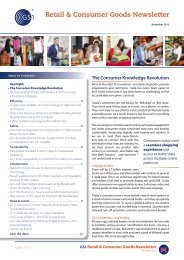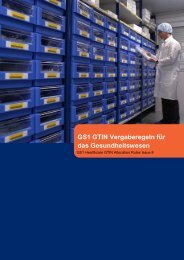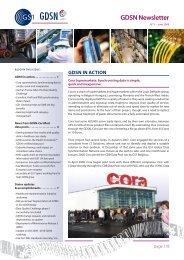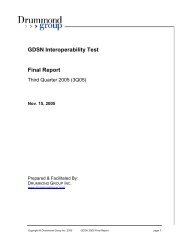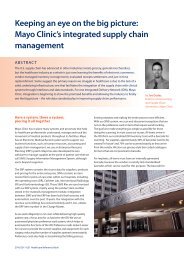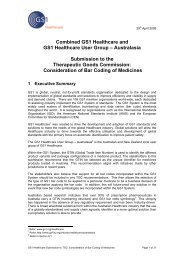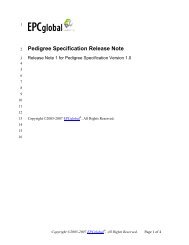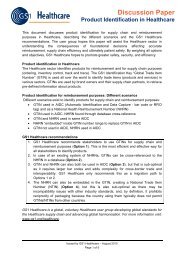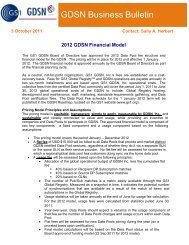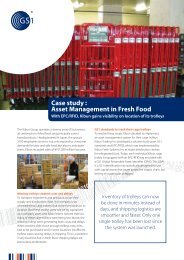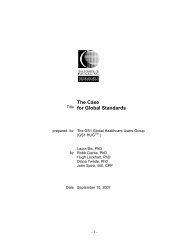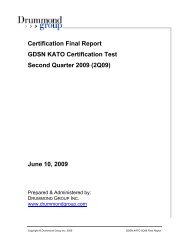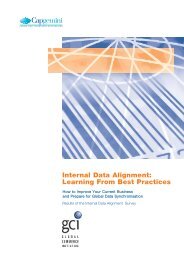The Application Level Events (ALE) Specification, Version 1.0 - GS1
The Application Level Events (ALE) Specification, Version 1.0 - GS1
The Application Level Events (ALE) Specification, Version 1.0 - GS1
Create successful ePaper yourself
Turn your PDF publications into a flip-book with our unique Google optimized e-Paper software.
Term Section Meaning<br />
2814<br />
2815<br />
2816<br />
2817<br />
<strong>ALE</strong><br />
(<strong>Application</strong><br />
<strong>Level</strong> <strong>Events</strong>)<br />
Layer<br />
2 Functionality that sits between raw EPC detection events<br />
(RFID tag reads or otherwise) and application business logic<br />
(an <strong>ALE</strong> Client). <strong>The</strong> <strong>ALE</strong> Interface is the interface between<br />
this layer and the <strong>ALE</strong> Client.<br />
<strong>ALE</strong> Client 2 Software, typically application business logic, which obtains<br />
EPC data through the <strong>ALE</strong> Interface.<br />
Event Cycle 3 One or more Read Cycles, from one or more Readers, that are<br />
to be treated as a unit from a client perspective. It is the<br />
smallest unit of interaction between the <strong>ALE</strong> Interface and an<br />
<strong>ALE</strong> Client.<br />
Read Cycle 3 <strong>The</strong> smallest unit of interaction of the <strong>ALE</strong> Layer with a<br />
Reader.<br />
Reader 3 A source of raw EPC data events. Often an RFID reader, but<br />
may also be EPC-compatible bar code reader, or even a person<br />
typing on a keyboard.<br />
Report 3 Data about event cycle communicated from the <strong>ALE</strong> interface<br />
to an <strong>ALE</strong> Client.<br />
Immediate<br />
Request<br />
Recurring<br />
Request<br />
Grouping<br />
Operator<br />
Physical<br />
Reader<br />
Logical<br />
Reader Name<br />
15 References<br />
2 A request in which information is reported on a one-time basis<br />
at the time of request. Immediate requests are made using the<br />
immediate or poll methods of the <strong>ALE</strong> Interface.<br />
2 A request in which information is reported repeatedly<br />
whenever an event is detected or at a specified time interval.<br />
Recurring requests are made using the subscribe method of<br />
the <strong>ALE</strong> Interface.<br />
5 A function that maps an EPC code into a group code. Specifies<br />
how EPCs read within an Event Cycle are to be partitioned into<br />
groups for reporting purposes.<br />
7 A physical device, such as an RFID reader or bar code scanner,<br />
that acts as one or more Readers for the purposes of the <strong>ALE</strong><br />
Layer.<br />
7 An abstract name that an <strong>ALE</strong> Client uses to refer to one or<br />
more Readers that have a single logical purpose; e.g.,<br />
DockDoor42.<br />
[ISODir2] ISO, “Rules for the structure and drafting of International Standards<br />
(ISO/IEC Directives, Part 2, 2001, 4th edition),” July 2002.<br />
Copyright © 2005, 2004 EPCglobal Inc, All Rights Reserved. Page 70 of 71



